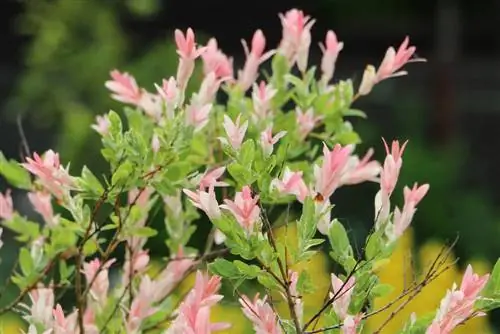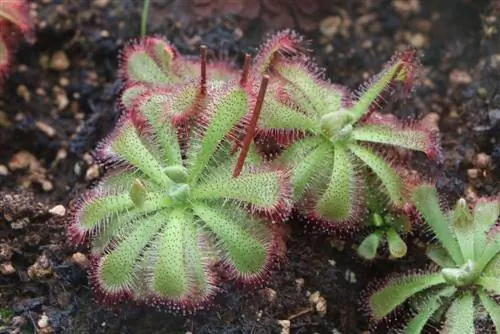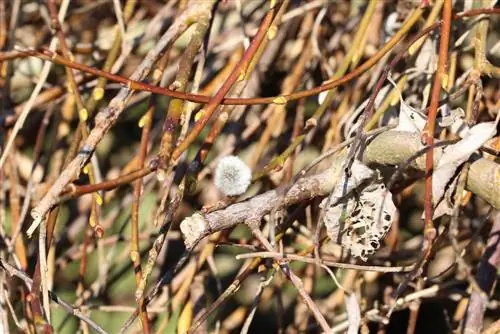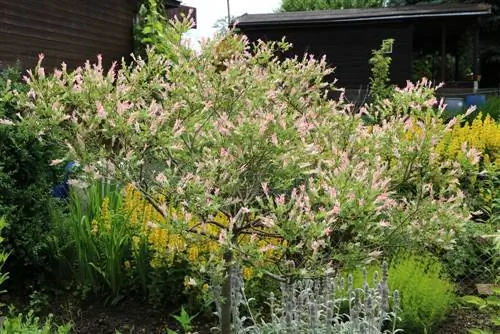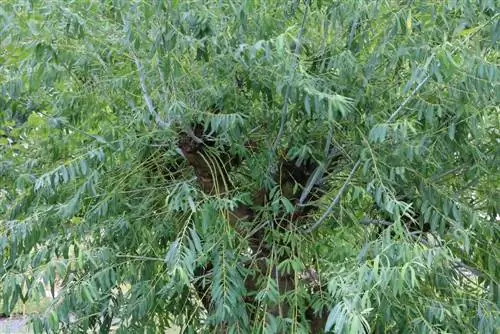- Author admin [email protected].
- Public 2023-12-17 03:39.
- Last modified 2025-01-24 12:45.
The best-known willow species undoubtedly include the white willow (Salix alba), the s alt willow (Salix caprea) and the osier or hemp willow (Salix viminalis) as well as the respective cultivated forms, some of which were even bred specifically for gardens and parks. Above all, the harlequin willow (Salix integra 'Hakuro Nishiki'), which comes from Asia, should be mentioned.
Willow varieties in Germany
White Willow
Many willow species grow rather shrubby. The white willow, on the other hand, grows almost exclusively as a single-stemmed tree that can easily reach a height of over 35 meters. Due to its impressive height alone, the white willow can only be fully recommended for larger gardens. Although the silver oak can be kept at a desired height through targeted cutting, its trunk can still be up to one meter thick. The silver oak also forms powerful roots.
Salwillow
The sage willow grows more in the form of a bush than a tree. Their average height is between two and ten meters, although under optimal growing conditions they can grow up to 15 meters high. It should also be mentioned that the willow can thrive even on stony soils and even on clay soils.
wicker
The osier usually grows into dense bushes that are on average between three and eight meters high. This means that wicker is ideal even for smaller gardens. However, it should be noted that they risk becoming “wild” if they are not regularly cut into shape.
Harlequin Willow
The Harlequin willow is a purely ornamental tree that remains significantly smaller than most of its natural counterparts. It also proves to be extremely easy to care for. In fact, it can even thrive wonderfully in a sufficiently large pot on the balcony or terrace.
Location
Willows are very undemanding plants that make little demands on their location in general and their soil in particular. This means they can thrive in both sunny and partially shaded locations. However, pastures generally require a lot of water, so they should be watered, at least in summers with little rain. It should also be noted that willows form huge roots, which is why you should not plant them in close proximity to the house, paved paths and terraces or artificial ponds. Of course, you also have to make sure that the floor is free of electricity, water and wastewater lines.
Cutting
Willows are extremely resistant to cutting. This means that you can cut off all branches completely without having to worry about it damaging your pasture. In fact, experts expressly recommend such rigorous pruning, especially since experience shows that the youngest shoots produce the most beautiful flowers. To get your willows into the shape you want, you can even shorten the thicker branches and trunk. However, when shortening the trunk, you should definitely make sure that the cut surface is slanted so that rainwater can drain away optimally. Otherwise there is a risk that the trunk will begin to rot due to stagnant moisture. It may also be advisable to seal the interfaces with special wound closure material. It should be noted that the wound closure agent not only serves to protect, but also allows the willow to grow into a specific shape. It is usually the case that new willow shoots form almost exclusively at interfaces.
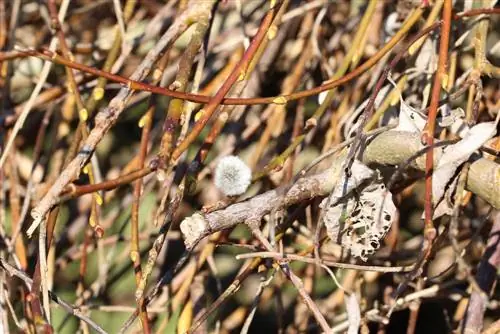
Traditionally, the willow is cut back in late autumn, but this is mainly because its canes are then particularly suitable for basket weaving. If it's just a matter of keeping the willow in shape, you can also cut it back in spring or even summer after the flowering period. However, you may shorten the willow branches by a maximum of half in summer to ensure that the willow retains enough foliage. However, you can remove all routes and shorten thick branches and the trunk until the beginning of February.
Cutting tips
You can cut smaller ornamental willows on your own without hesitation. For larger pastures, however, you should have helpers with you just for safety reasons. In addition, your helpers can immediately clear away the cut rods before the flexible branches on the ground become an insoluble tangle. Of course, pruning must be paused while your helpers move the rods out of the way. It is also advisable to shorten the rods from the outside inwards before cutting them off completely.
Tip:
For larger pastures, you should rent a so-called cherry picker, which makes working at height comfortable and, above all, safe.
Propagate
A special feature of the willow is that its severed canes are almost 100% likely to grow their own roots as soon as they come into contact with enough water. So to propagate your willows, all you have to do is cut off a few canes and place them in the water. As soon as the canes have put down enough roots, they can be planted in the garden. To ensure that the cuttings grow optimally, it is advisable to water them regularly, at least initially. Alternatively, you can simply stick the separated rods directly into the ground with their interface first. However, the soil must be kept constantly wet, which is why the first option mentioned should prove to be much easier and more comfortable. By the way, the best time to propagate is the end of February, although depending on the cutting date you can of course also let willow branches root in early autumn or summer.
Tip:
If you want to create a living privacy screen, you can lay thicker branches lengthwise on the ground and intertwine the young shoots that sprout from them so that they will grow into an absolutely opaque and incredibly decorative wall.
Wintering
Willows that were planted directly in the garden do not need any special winter protection. For willows that are in pots, however, it is advisable to wrap the pots with an insulating material, such as bubble wrap, so that the willow roots are adequately protected from cold and frost.
Frequently asked questions
Are pollard willows actually a separate species of willow?
Polar willows are not a separate type of willow, but rather just willows that have been cut in a special way.
Can pastures be moved?
At least younger pastures can be moved without any problems. However, you must be careful to damage their roots as little as possible. You should also cut back your pasture heavily before moving it to make your work easier and reduce the nutrient requirements and weight of the pasture.
What can I do if the main trunk of my pasture has broken off?
As a rule, broken willows sprout new shoots again. However, it should be noted that commercially purchased willows are usually grafted plants in which willow shoots of a particular willow species have been grafted onto the trunk of another tree species, so you may have to graft your own shoots yourself.
What you should know about pastures in brief

There are different types of willow in Germany. They grow as trees and bushes. If it is a he althy willow tree, it can reach a height of thirty meters. Willows that grow as shrubs can grow to between 40 and 60 cm tall.
- Weeping Willow,
- White willow,
- Broken willow,
- Sal willow,
- wicker
- and purple willow
are among the best-known willow species in Germany.
Care
- The willow species in Germany are often planted in large gardens because they require little care and are very easy to grow.
- To prevent the willow from growing out of control, it should be trimmed regularly.
- Willows love sunny and moist places. The soil should not be too dry or rich in lime.
- Willows grow and thrive in moist soil. You can therefore often find them along streams.
- Willow trees grow tall and therefore only diseased or dead shoots need to be cut off.
Propagate
- A freshly cut, he althy piece of willow can simply be placed in the moist soil and it will sprout on its own.
- The branch forms roots after a certain time and simply grows back as a new tree.
- Willow cuttings should be planted with sufficient distance as the tree can reach a diameter of one meter.
- If willow bushes are planted in the garden, they must be cut back regularly, otherwise they will grow uncontrollably.
- The bushes can easily be cut as desired.
Bee Pasture
- Flowering willows (catkins) are a source of food for bees.
- These willow species in Germany should, if possible, only be pruned after the flowering period, as the shoots can then grow back better.
- The pussy willows are also often used by florists to embellish spring bouquets.
- But the individual branches with the pussy willows also look particularly beautiful in a vase.
Willow as a privacy screen
Many garden owners use the dense willow bushes as a privacy screen for their garden. Since the willow grows very densely and, above all, quickly, it is often used as a hedge or privacy screen. The dense branches and leaves make prying eyes from neighbors impossible. Despite the ease of caring for willow trees, the soil should always be kept moist. This is especially true in the warm spring and summer months, otherwise, in the worst case scenario, the willow will not be able to grow sufficiently and he althily. Willow trees provide plenty of shade in summer and delight garden owners with their deep green leaves. A willow is a great plant that has enchanted many gardeners with its flowers and simplicity.

